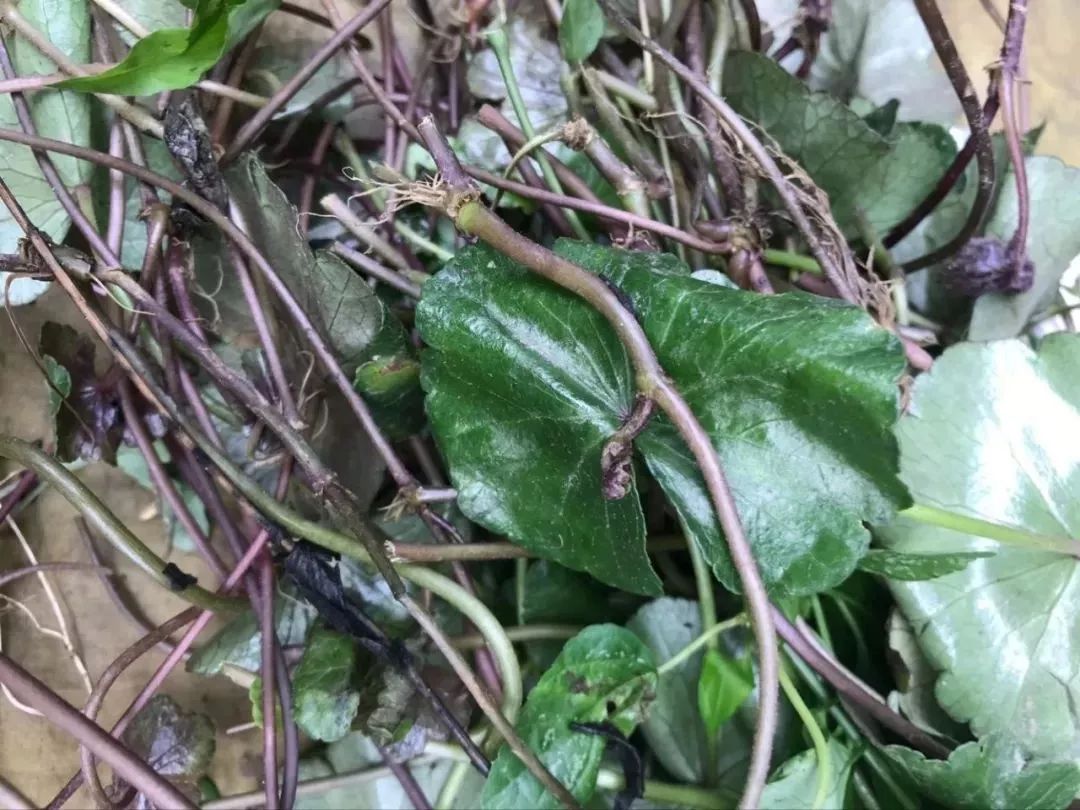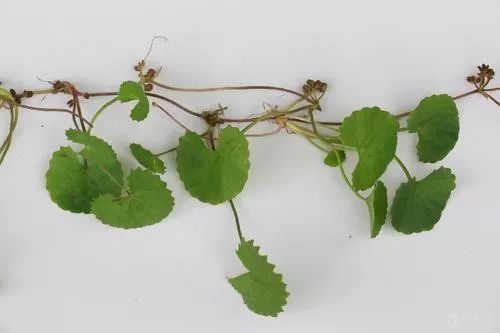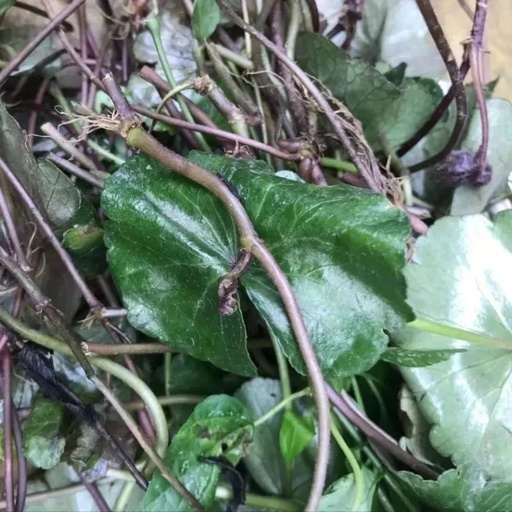
Guangdong is a hub for herbal tea, and Jixuecao (Centella Asiatica) herbal tea is one of them.
Every summer, there are small stalls on the streets selling Jixuecao herbal tea. Vendors push wooden carts with transparent glass cups filled with dark green fresh Leigonggen (Radix et Rhizoma Notopterygii) juice, adding an appropriate amount of rock sugar, chilling it, and storing it in enamel thermos tea jars, layered on the cart, with fresh Jixuecao piled on top as a natural advertisement. Passersby and residents out for a stroll can’t resist buying a cup to cool off and disperse wind-heat.
Jixuecao, a poetic name, has extraordinary medicinal effects!
It belongs to the Apiaceae family and is a perennial herb that grows in low, moist areas by fields and ditches. Its stem is creeping, slender, and roots at the nodes. The leaves are membranous to herbaceous, round, kidney-shaped, or horseshoe-shaped, with blunt serrations on the edges, and are hairless or sparsely hairy on the back along the veins.
The umbel peduncle clusters in the leaf axils, with or without hairs. Each umbel has 3-4 flowers, clustered in a head-like formation. The petals are ovate, purple-red or milky white, and membranous. The filaments are shorter than the petals or equal in length to the ovary. The fruit is flattened on both sides, spherical, with a heart-shaped to flat base. The flowering and fruiting period is from April to October.
It has many colloquial names.
For example, “Bengdawan” is the name used in Guangdong, likely related to making soup or brewing herbal tea in a large bowl. It carries a rustic charm. As a wild vegetable, people in Guangdong like to use it to brew herbal tea. In some places, it is used in cooking, such as using the fresh, slightly tender whole herb (the older ones are more bitter and astringent), cleaned and chopped finely, paired with fish or pork to make soup, delicious and cooling.
Lianqian Cao (Moneywort), named for its round, green leaves that resemble coins strung together.
Huangdancao (Jaundice Herb), named for its ability to treat jaundice.
Leigonggen (Radix et Rhizoma Notopterygii), the root of Jixuecao, is said to sprout due to spring thunder. Shortly after the thunder of the awakening of insects, Leigonggen emerges in the fields, beginning to spread and grow.
Used medicinally, the whole herb is bitter and pungent, with a cold nature. It enters the liver, spleen, and kidney meridians. It has the effects of clearing heat, promoting diuresis, detoxifying, and reducing swelling, and can treat damp-heat jaundice, heatstroke diarrhea, stone lin syndrome, blood lin syndrome, carbuncles, abscesses, dysentery, abdominal pain, contusions, and injuries.

Selected Formulas:
1. For Damp-Heat Jaundice: 30g of Jixuecao, 30g of rock sugar. Decoction for oral administration. (From “Jiangxi Folk Herbal Medicine”)
2. For Jaundice-Type Infectious Hepatitis: 15-30g of fresh whole Jixuecao; or add 15g of Yinchenhao (Artemisia capillaris), 6g of Zhizi (Gardenia fruit), and 15g of rock sugar. Decoction for oral administration. (7-8 formulas from “Fujian Chinese Herbal Medicine”)
3. For Acute Cholecystitis: 30-60g of Ma Ti Ye (Horsetail leaves), 15g of Ma Wei Huanglian (Coptis chinensis), and 15g of Longdan Cao (Gentiana scabra). Decoction for oral administration. (From “Yuxi Chinese Herbal Medicine”)
4. For Liver Enlargement: 250-500g of Bengdawan. Decoction for oral administration. (From “Lingnan Herbal Medicine”)
5. For Sand Lin Syndrome: 30g of Jixuecao. Decoction with the second washing water of rice for oral administration. (From “Jiangxi Folk Herbal Medicine Proven Recipes”)
6. For Blood Lin Syndrome: A handful each of Jixuecao tops and Caoyigeng (Herba Hedyotis). Mash and squeeze juice with 30g of rock sugar, stew and consume at once. (From “Mindong Materia Medica”)
7. For Urinary Retention: 30g of fresh Jixuecao, mash and apply to the navel; remove the herb once urination is achieved.
8. For Dysentery: 60g of fresh whole Jixuecao, or add 30g each of Fengweicao (Pseudostellaria heterophylla) and Zihua Diding (Viola yedoensis). Decoction, adjust with rock sugar and honey for consumption.
9. For Red and Swollen Eyes: Mash fresh Jixuecao and apply to the acupoint at the wrist, or mash and squeeze juice to drop into the affected eye, three to four times a day. (From “Jiangxi Folk Herbal Medicine”)
10. For Styes: Clean fresh Jixuecao, mash and mix with brown sugar for application. (From “Quanzhou Materia Medica”)
11. For Sore Throat: 60g of fresh Jixuecao. Clean, mash in a bowl, pour hot water to extract juice, wait until warm, and gargle frequently. (From “Jiangxi Folk Herbal Medicine”)
12. For Whooping Cough: 150g of Bengdawan and 30g of lean pork. Stew for one hour, divide into two doses, and take for several days.
13. For Hemoptysis, Hematemesis, and Epistaxis: 60-90g of fresh Jixuecao. Decoction or juice for oral administration. (From “Fujian Chinese Herbal Medicine”)
14. For Asthma: 30g of dried Jixuecao, and 15g each of Huangdancao and Beilidan (Sargassum). Decoction for oral administration. (From “Fuzhou Military Region Chinese Herbal Medicine Manual”)
15. For Cold and Headache: 30g of Leigonggen and 9g of ginger. Mash and apply to the forehead. (From “Guangxi Commonly Used Herbal Medicine Manual”)
16. For External Heat Fever, Thirst, and Delirium: 60g of Leigonggen and 4 earthworms. Mash together, boil in water for an hour, then take the juice. (From “Guangxi Commonly Used Herbal Medicine Manual”)
17. For Lung Heat Cough: 30g each of Jixuecao, Dimai Dong (Ophiopogon japonicus), and Baimao Gen (Imperata cylindrica), and 15g each of Pipa Ye (Loquat leaves) and Mulberry leaves. Decoction for oral administration. (From “Sichuan Chinese Medicine Records 1960”)
18. For Heatstroke Diarrhea: Fresh leaves of Jixuecao rolled into small balls, chewed finely, and swallowed with water. (From “Zhejiang Commonly Used Herbal Medicine”)
19. For Measles: 30-60g of Jixuecao. Decoction for oral administration. (From “Guangzhou Military Commonly Used Chinese Herbal Medicine Manual”)
20. For Carbuncles: Fresh Jixuecao, cleaned, mashed, and applied to the affected area. (From “Jiangxi Folk Herbal Medicine”)
21. For Waist Fire Rash: Fresh Jixuecao, cleaned, mashed, and squeezed juice mixed with an appropriate amount of glutinous rice flour to form a thin paste, applied to the affected area. (From “Jiangxi Folk Herbal Medicine”)
22. For Contusions and Injuries: 30-60g of Jixuecao, mixed with 250-500ml of red wine, stew for one hour, take internally; the residue can be mashed and applied to the injury. (From “Fujian Folk Herbal Medicine”)
23. For Swelling and Pain from Contusions: 30g of fresh Jixuecao mashed and squeezed for juice, mixed with wine, and taken warm; the residue can be applied to the affected area. (From “Fujian Chinese Herbal Medicine”)
24. For Bleeding from Knife Wounds: Bengdawan, in appropriate amounts, mashed and applied externally to the wound. (From “Lingnan Herbal Medicine”)
25. For Chronic Ulcers on the Lower Leg: Fresh Jixuecao, cleaned, mashed, and applied to the affected area, changed once a day. (From “Jiangxi Folk Herbal Medicine”)

26. For Fishbone Stuck in Throat: Decoction of Leigonggen for internal use, swallow slowly while taking. (Formulas 17-19 from “Lingnan Herbal Medicine”)
27. To Relieve Mushroom Poisoning: 250g of Bengdawan and 100g of rock sugar. Decoction for internal use; or 250g of Bengdawan and 500g of radish, mashed and juiced for internal use. (Formulas 20-22 from “Southern Major Toxic Plants”)
28. For Accidental Ingestion of Arsenic or Other Food Poisoning: 250g of Leigonggen and 3g of Dan Fan (Copper Sulfate). Decoction for oral administration. This formula also treats poisoning from Gou Wen (Aristolochia debilis) and mushrooms.

